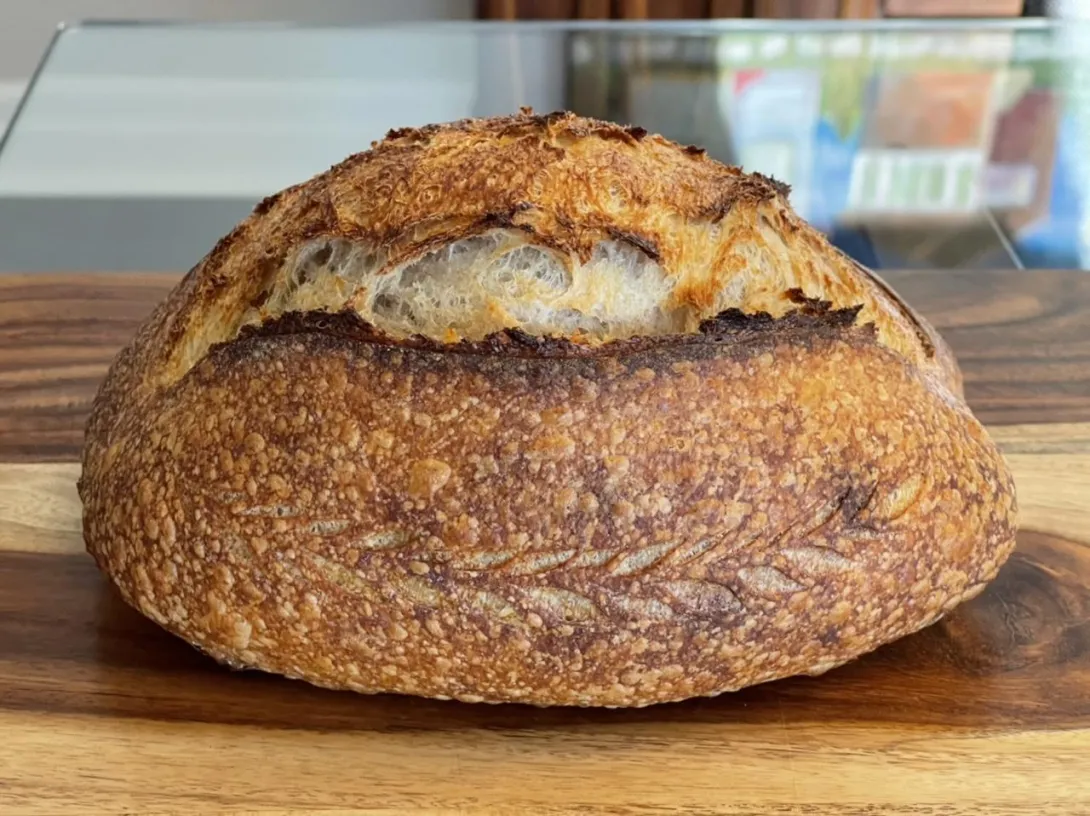
A recent blog post about grain mash is awesome if you haven’t read it yet. Reading it motivated me to apply saccharification to the polenta porridge thinking it might enhance the flavour of the polenta. As you know saccharification of the polenta brings out its sweetness that is hidden in the starches in the polenta. Adding the diastatic malt and holding it at a warm, but not too warm temperature will allow the diastatic malt (amylase) to break down theses starches to sugars which we will be able to taste as the natural sweetness in the polenta that otherwise would be hidden from our tastebuds.
I used my Instant Pot and after a bit of experimentation found that using its Keep Warm setting Normal holds a temperature of 148°F for up to ten hours. After cooking the polenta I placed it into a jam jar lightly capped and placed it into a water bath in the instant pot and cooked it for 6 hours. Comparing the flavour pre and post water bath the difference was remarkable. After six hours the porridge had a lovely sweetness that wasn’t there prior to the six hours at 148°F. When using the Instant Pot for this saccharification process put the lid on but keep the vent open so there is no pressurization of the pot.
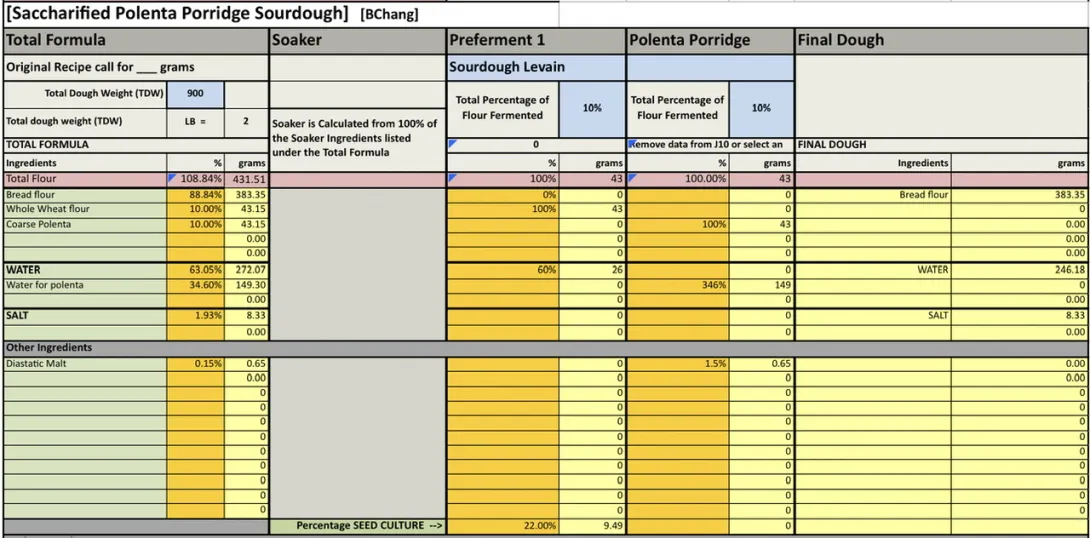
Cook coarse corn meal with the water until softened and water fully absorbed. Once the temperature is down to 150°F or less add the diastatic malt and mix well.
Place the corn porridge in a jar, covered lightly and place in a water bath in an instant pot. Set to [keep warm] normal (148ºF) for 3-6 hours. I did 6 hours.
Build levain overnight with the aim to be at peak in the morning. At 76°F 3x rise and dome flattening at 11 hours.
Add water and salt to the bowl of a stand mixer, dissolve salt. Add the stiff levain and break into small pieces. Add the bread flour, mix on speed 1 until no dry flour remains. Rest for 10-15 mins. At medium speed mix to develop the gluten. When the gluten is moderately to well developed add the polenta porridge in small aliquots. Mix until well incorporated.
Bulk fermentation aiming for 40% rise to shape. Perform coil folds every 30 mins until dough is strong and isn’t spreading.
Once the pH has dropped by 1.0 then shape the dough into a batard and then start final proofed shaped and resting in a banneton.
Once the pH has dropped by a further 0.3 it will be time for baking. Place the dough in the freezer when the pH drops by 0.25 and then pre-heat oven at 500°F with cast iron skillet in the oven and set up for open steam baking. 30 mins prior to baking, pour 1 L of boiling water into metal loaf pan with Sylvia towel and place on baking steel on the lowest rack of the oven.
Once oven reaches 500ºF turn dough out of banneton, brush excess rice flour off, score and then brush with water. Transfer to oven. Pour 250 mL of boiling water into the cast iron skillet on a high shelf, high enough that the dough have fully bloom. Drop temperature to 450ºF and bake with steam for 25 mins. Then vent oven and remove all steaming gear and drop temperature to 425ºF. Bake for another 25-30 mins rotating as needed.
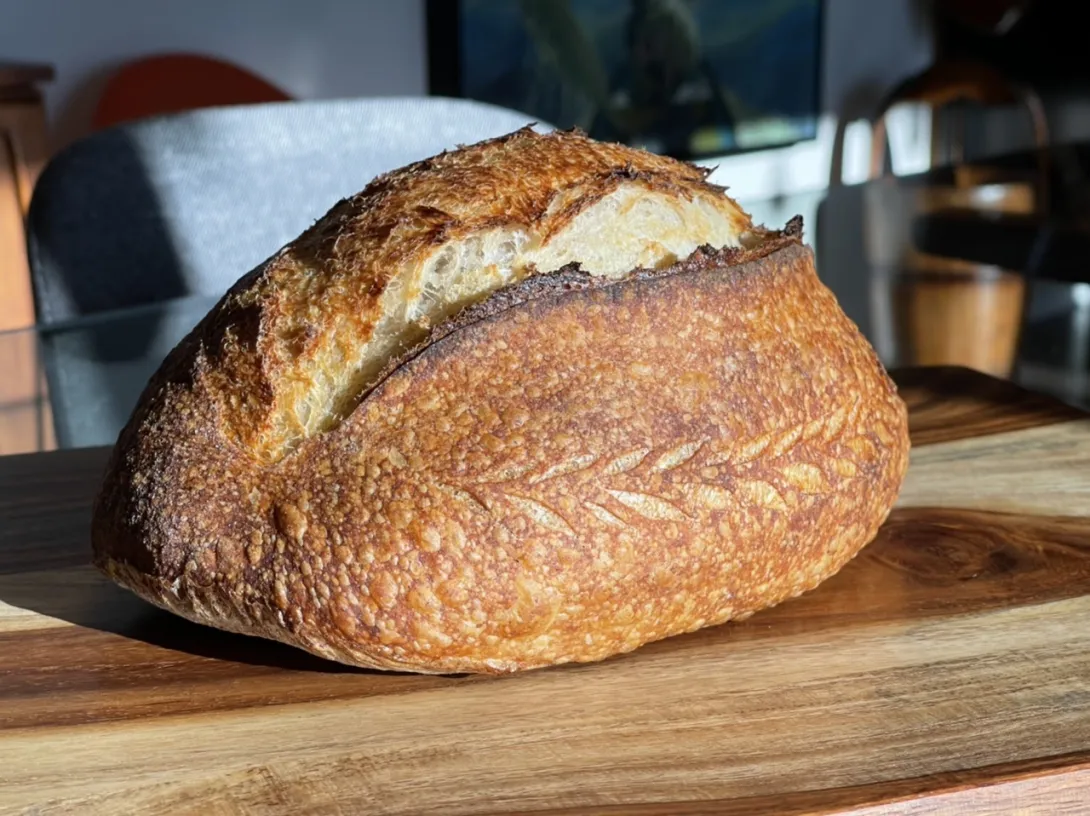
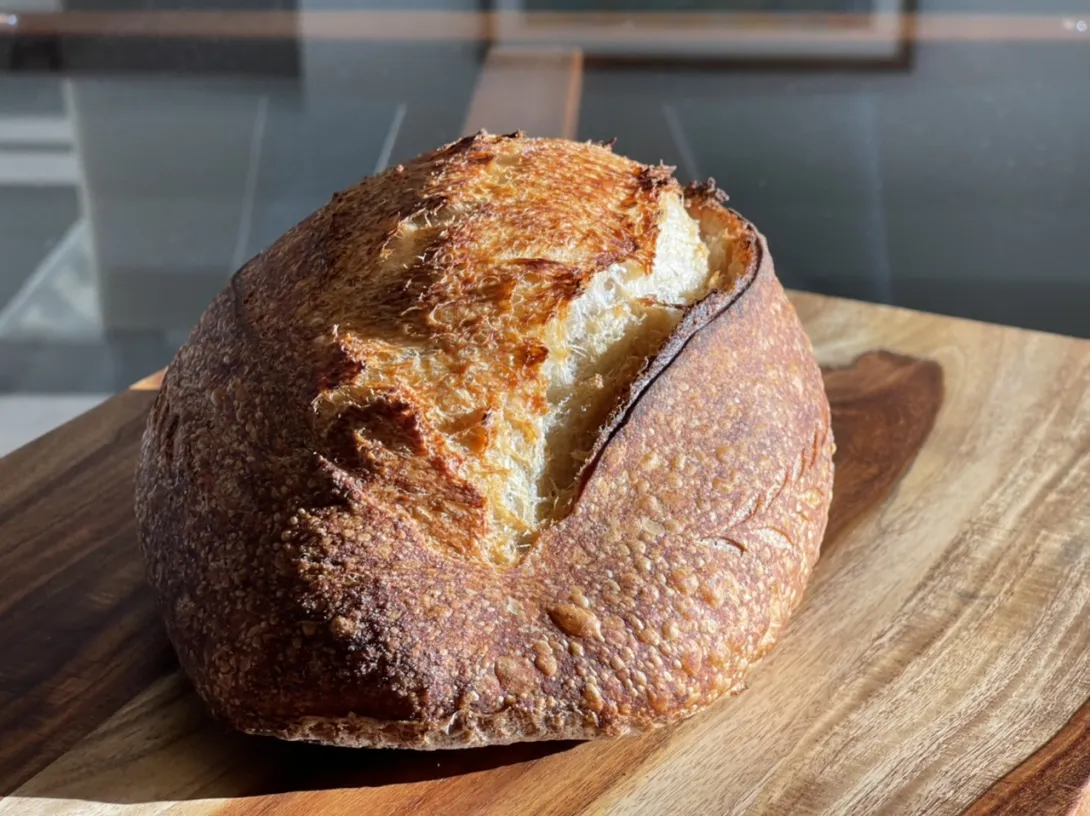
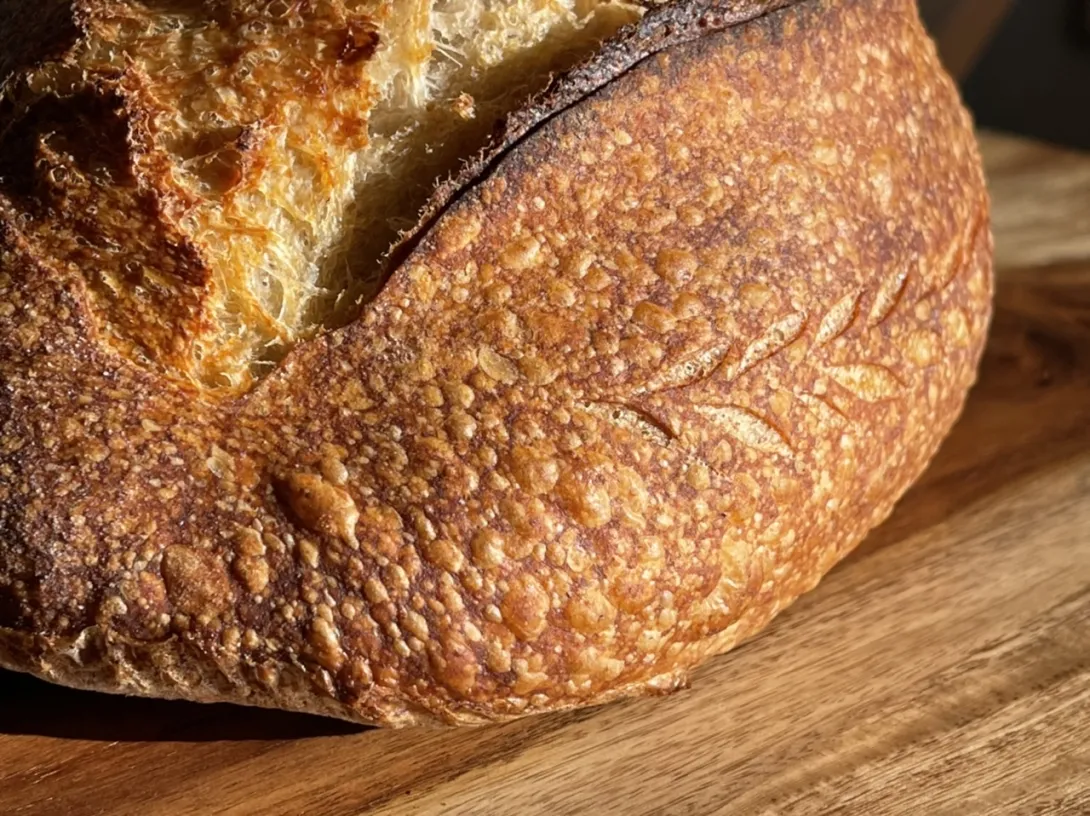
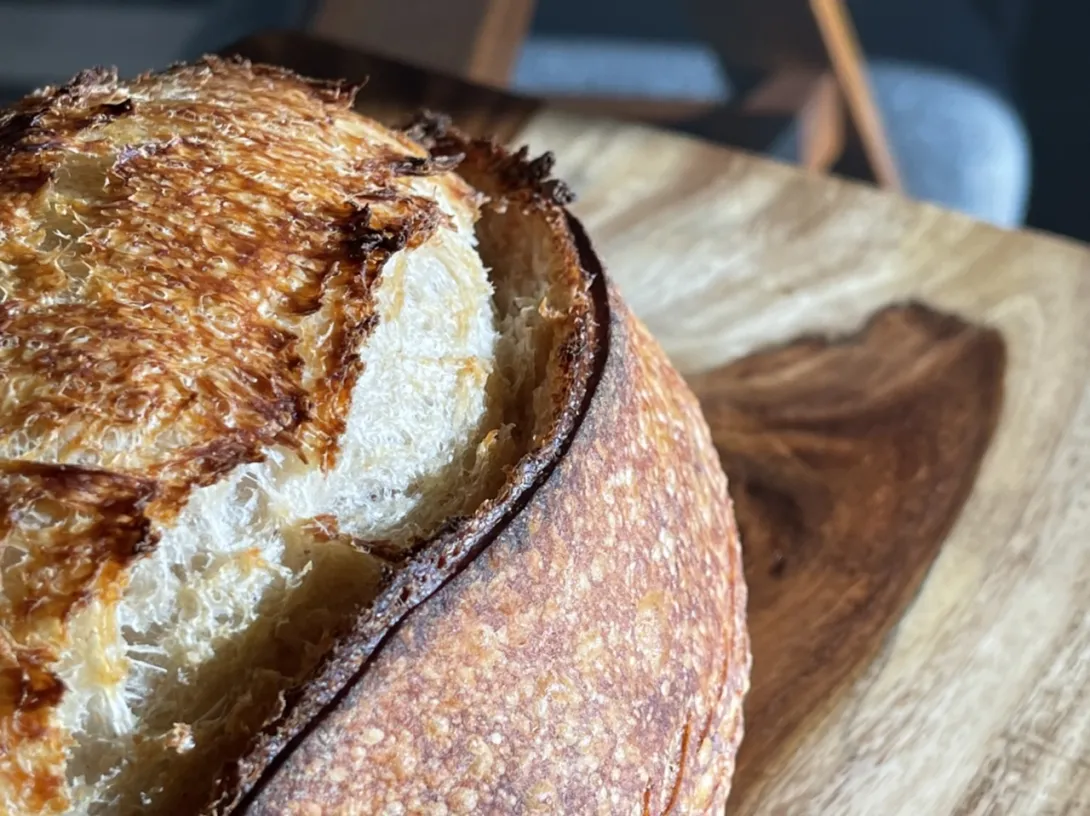
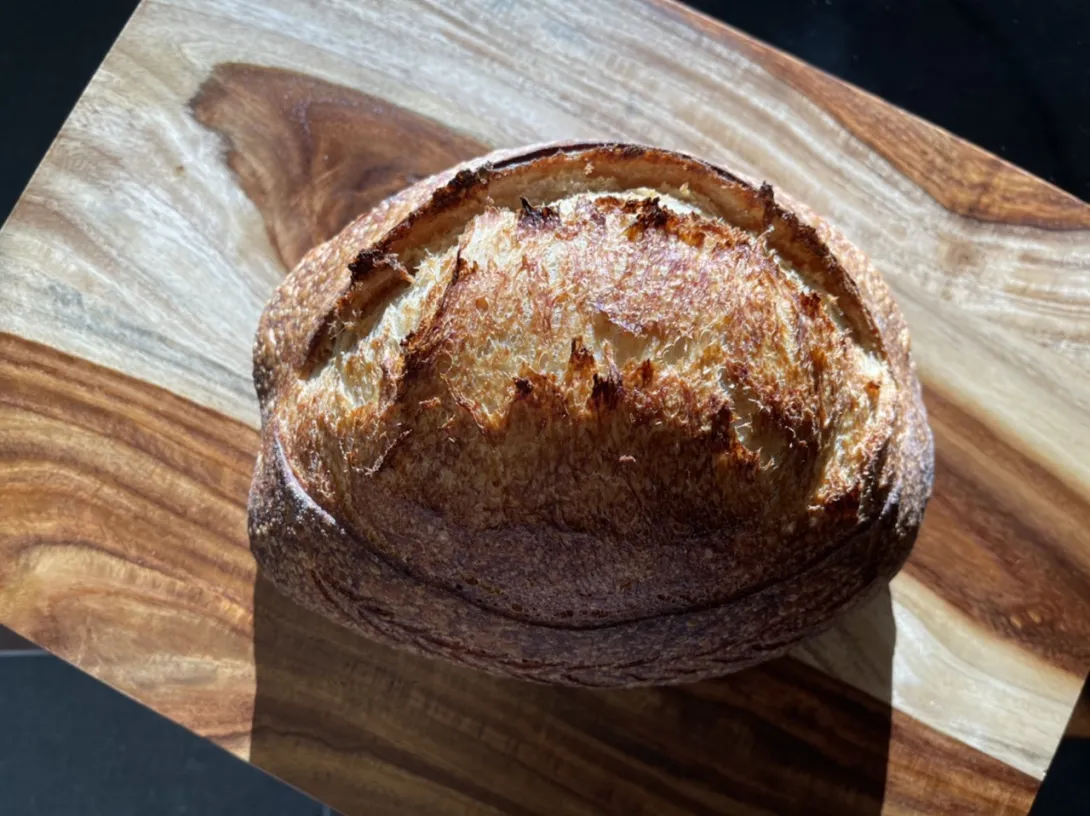
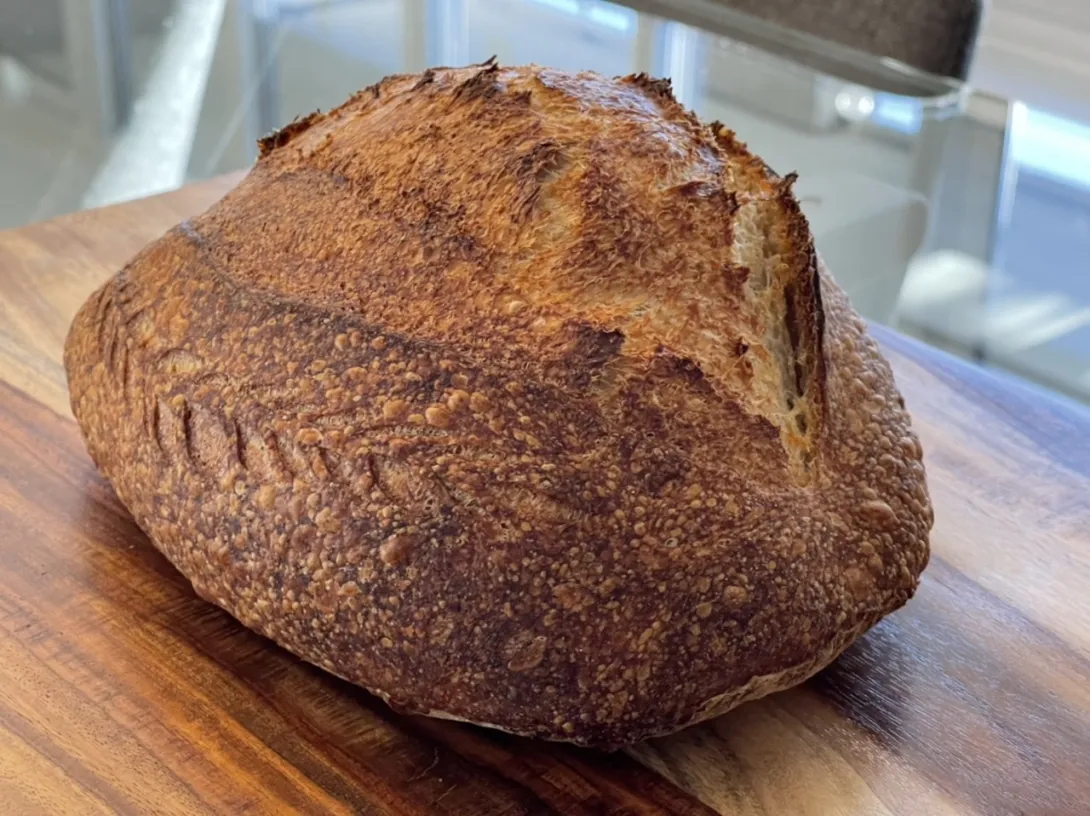
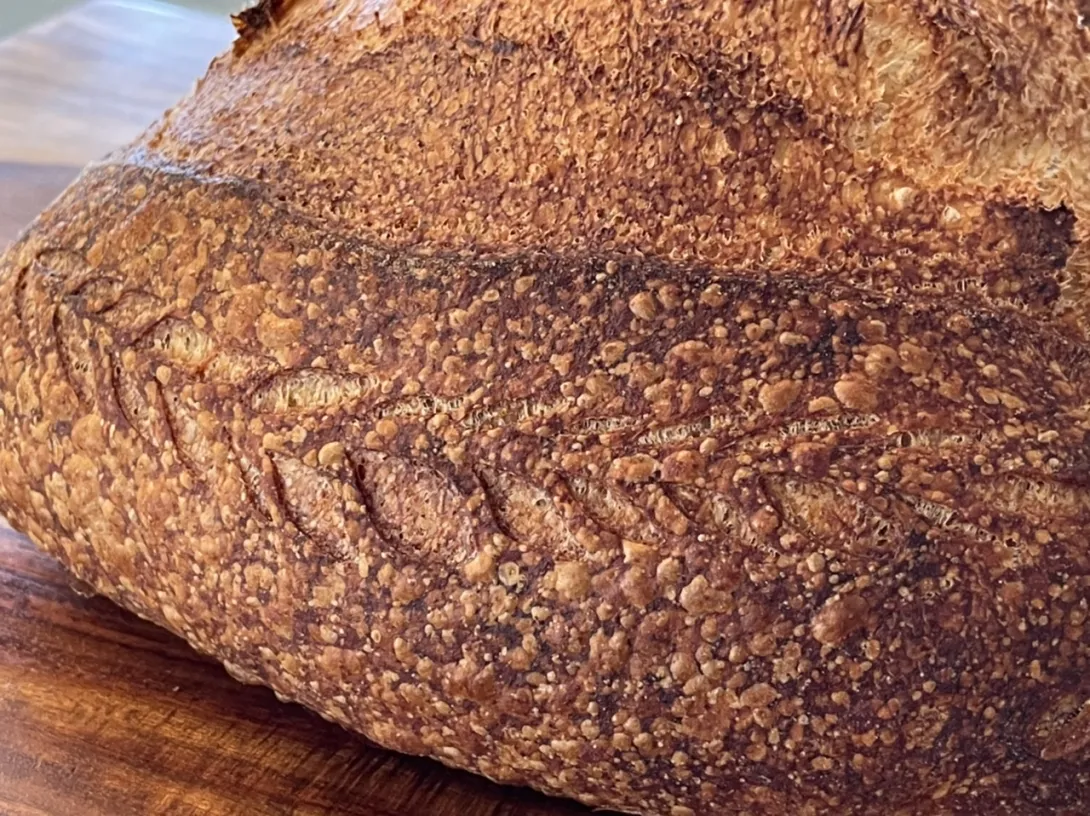
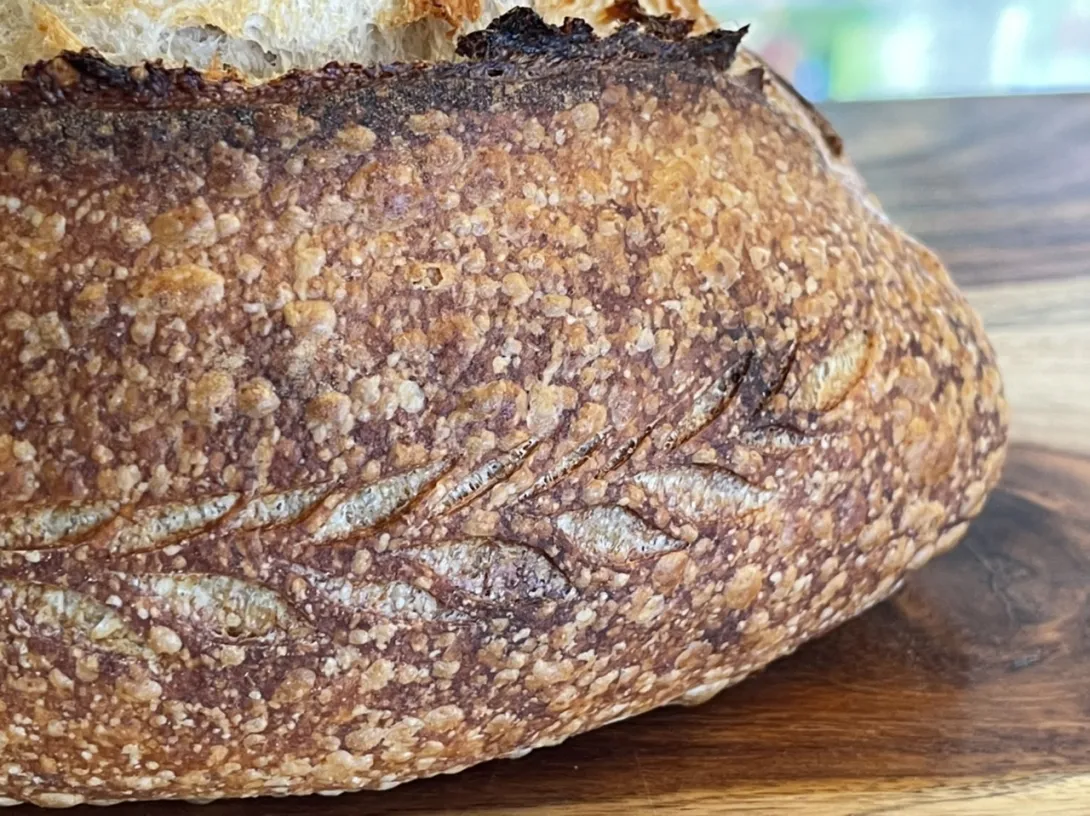
- Benito's Blog
- Log in or register to post comments
I put together a short video showing how I scored this loaf, enjoy.
Beautiful loaf, and a really interesting technique.
Would you mind if swapped out your Hokkaido milk bread post on the home page for this one?
I would be honored Floyd thank you.
Benny
That's awesome. 😊
Thank you Billy.
Beautiful bread as usual, Benny!
I especially like how you explored the IP feature and made the mash effortlessly. Super cool! 😎😎😎
Yippee
Thank you Yippee, I really love the Instant Pot and have recently found new uses for it such as this saccarification and making amazake.
Benny
Really nice bake Benny! Love the breadth of color you achieved and that bloom is tremendous!
Whenever I’ve done a corn mash, I find the bloom goes a little higher and fermentation goes a little faster. Did you experience the same? You mention 40% volume increase but then a pH drop of 1.0. Does it always work out that a drop of 1.0 is about 40%, or do you focus more on pH and let the volume rise fluctuate?
Thank you Troy. This Saccarified polenta dough moved faster than the previous polenta dough I did. I’m sure it was the higher sugars in the Saccarified polenta that caused this. I’d say it cut down bulk by about 45 mins or so.
I wish the pH drop of 1.0 always matched a rise of 40%. They often do for me, but not always and when they don’t it is a judgement call and usually the pH wins.
Benny
The flavour is wonderful, the saccharification of the polenta definitely brings out the corn flavours more than my previous bake and with more corn sweetness. On the other hand, I did also increase the amount of polenta in this bake too so that would impart more flavour on its own as well. As with most porridge loaves the crumb is a bit more custard like which is lovely. This bread made excellent sandwiches for dinner last night.
I would push fermentation a bit further next time and aim for a total pH drop of 0.4 in final bulk assuming the same pH drop of 1.0 during bulk for a total pH delta of 1.4. The dough is strong enough with so little whole grain I suspect it could have handled a bit more fermentation.
Another wall hanger! The bread looks great and you managed to get a nice open crumb to boot. The slow cooked fermented mash is an interesting process for flavor development that I am gonna have to try. Thanks for bringing it to our attention now I wish I hadn’t given our crockpot away. Benny, You may not be a surgeon but you are on the cutting edge when it comes to bread.
Thank you kindly Don, I appreciate your comments. Maybe I should have been a surgeon, too late for that now though!
I hope you try saccarification of your porridges, it is such a simple way to getting more out of our grains. I’ll need to try this on a tangzhong soon for a Hokkaido milk bread.
Benny
Your bakes always have an interesting twist :)
Best,
dw
Thank you Debra, that is really nice of you to say. I do like to try different things to keep it interesting. Fortunately with baking, there are so many different techniques to play around with.
Benny
Will bake tomorrow. There’s no way I will get such a beautiful blistery crust, but looking forward to the results anyway.
That’s great, I’ll look forward to your bake. If you want a blistered crust, do a long cold retard and then prior to baking brush off any excess flour and brush on water with a pastry brush.
Benny
And the dough never really came together. Maybe the cornmeal I used was not appropriate. What was the texture of your porridge like when it went into the dough? Mine became very liquid over time.
Yes mine became a bit wetter as well. I would reduce the water in the porridge, maybe try 1:2.5 or 1:3 ratio of corn meal to water in the future. I’m sorry if it didn’t work out for you. I thought I had posted that I’d reduce the water in the future somewhere in this thread. Don’t give up on it.
Benny
definitely try again soon! I just don’t know what I’m doing with porridge breads yet.
I got some real polenta, which did make the porridge thicker. The dough was still very weak when it was first mixed, and I thought I might be in for another disaster, but it strengthened up nicely as it sat. I think it will work this time!
That’s great to hear 🤞🏻🤞🏻
Thanks for the heads-up on this technique Benny. Enhancing a corn flavor note without compromising crumb quality is a worthy objective. And reducing staling rate? Hat trick!
Note that I think you’ve left out an “h”-saccharification. Like saccharine.
Will try this for sure. Thanks!
Tom
Thanks so much Tom. Funny, the article I read about this method and similar spelt it without the h multiple times so it never occurred to me to check on this spelling. But I guess you’re right, it should have an H in it. I’ll edit that now.
Benny
I always remember that H from association with C&H Sugar.
T
Benny, curious if you noticed any gumminess and how did you cook the polenta? The final step I usually do with a mash is to take the temp up to 180 deg F after the long hold at 150 deg F. The thought being to denature the amylase that can attack gluten during fermentation (can't remember which amylase that is).
If you didn't get any gumminess, do you think it was because of the shorter fermentation time or do you think you denatured the enzymes by cooking the polenta and then added back only the enzymes you want with the diastatic malt? I ask because taking the temp up adds another significant chunk of time and it would be nice to get rid of that step.
The crumb was a but custard like but I wouldn’t have called it gummy. I didn’t cook the polenta after the saccharification step, but that is a good idea to avoid the potential gumminess from excess amylase activity. Although it shouldn’t affect the gluten it can cause starch attack causing gumminess if there is too much used. In my formula there is only about 0.15% and I’ve never seen gumminess until I’ve used much much more.
Edited to add, I simply cooked my polenta in a small pot on the stovetop.
Benny
Thanks Benny. Have requests for a few porridge breads from my folks this week. Great opportunity to experiment. :-)
I’ll look forward to seeing your new experiments Troy!
I really like the idea of a second heating to denature the amylase. Corvus, in the Breadtopia post, is counting on the acid in the preferment to prevent the amylase from gumming things up but that seems trickier to get right than simply heating a second time.
I'm going to try that next bake.
Good idea Gary, I'll have to remember to do that as well.
Very interesting technique with the porridge. I will have to give this a try. I’ve yet to experiment with PH readings…..it’s a little bit too much for me but your consistency with such great crust and crumbs may push me over the edge! I’m sure the flavor must be spot on.
Best,
Ian
Thanks so much Ian, there are so many different things one can do with our doughs, it never ceases to amaze me. It’s always fun to try something a bit different. We enjoyed the flavour of this bread quite a bit and the crumb had that lovely custardy texture one often gets in porridge loaves. Doing the pH isn’t much work at all, give it a try.
Benny
Thanks for the article. My pressure cooker keeps water warm at 162, do you think this will work?
Thanks
The best way of finding out is trying it. But I believe amylase denatures at 185°F so it should work, but it shouldn’t take as long.
Benny
Very nice color, and crust !!
Thank you Ricky and now it is gone, I’ll have to do another porridge loaf soon.
Benny
Have been away traveling so I missed this. Well done, admiring the technical skill to pull this off. When I tried maize meal in a bread I couldn't get the hydration of the final dough right. And although it was sweet because I used a food flask, saccharification is in a different league of technical excellence altogether. Well done, it looks like there is very little that could be improved here.
You didn't mention the duration of fermentation to get to 40% - did you perhaps take note of it?
Cheers,
Jon
Thank you Jon, I hope you had a nice vacation away! The saccharification isn’t hard at all, make the porridge/polenta, cool it below 150°F add diastatic malt and then keep the temp around 150°F for several hours and you’re done. All you need is a way of holding that temperature, the instant pot is perfect for this.
40% rise at 82°F was about 4 hours or so.
Benny
I don’t have a PH tester for my dough and always go by size and feel. Do you have any suggestion after the 40% bulk fermentation for what I should look for? Your bread looks amazing!
My notes indicate that the dough had a total rise in the aliquot jar of 64% at the time of the beginning of cold retard. I hope that helps!
Benny
That does help a lot. Thanks.
Came out fine looking like yours. I used the Loafnest which works well for batards with high hydration doughs requiring longer rises and little kneading.
I used it because perhaps I mis-read your worksheet? This dough was quite hydrated and the reason I used the Loafnest.
Also, and by accidentally (bcz my starter needed more time than I thought it might) I autolysed the flour for 24 hours which is probably not relevant and in any case might have improved the result.
Worked just fine. The loaf looks just like your picture, nice crumb. But the flavor wasn't particularly notable.
This may be all my bad. Perhaps you could explain your worksheet or post a link to it so I may see the formulas?
Thanks in advance.
FYI only: The newer InstantPots have a custom keep warm function allowing one to set the temperature to 148 and thaty worked just fine.
I’m glad you gave it a try.
The spreadsheet is somewhat self explanatory. The far right column shows the weights of ingredients for mixing the dough. The far left shows the total weights of all ingredients which includes the levain and polenta porridge. The levain column gives you the weights used to make the levain and similarly the polenta porridge column shows the weights of ingredients for the polenta porridge.
Benny
This is a lovely bread, Benny. I tried it the other night and was amazed at the transformation of the polenta to something almost pudding-like in sweetness. I can't wait to try this on some sort of dessert, I think it would be fantastic.
I followed a little different method than yours, incorporating the polenta into my "standard" sourdough formula that adds an overnight refrigerated retard step. The polenta made the crumb especially moist with a very nice mouthfeel, and the crust was highly blistered and nicely chewy. Interestingly, I didn't notice any significant impact on the flavor profile from the polenta, although the flavor was very good overall. Just as a data point, I measured the pH at 5.2 when the loaf was put into the refrigerator and 5.0 when it went into the oven about 12 hours later. Just curious about your impressions of the flavor profile when you made it. Thanks.
-Brad
I’m glad you tried this Brad and I think the cold retard is a good idea. I had done a polenta bake previously without the saccharification step and compared to that, there was more corn flavour and sweetness. I can’t say that the bread is super corn forward. I think we’d have to increase the percent corn polenta for that. I guess another bake is due.
Benny
Hi! First post on this forum :)
I saw your recipe and thought it was super interesting so I decided to make a similar loaf. Notably, instead of saccharifying polenta, I used masa harina.
Very happy with the results! Definitely got a lot more LAB activity and acids than my normal bakes get, I'm assuming due to the released sugars from the saccharified masa. Delicious, thanks for the inspiration :)
Total
* Note: I didn't include any of the water that is in the saccharified masa harina in the "water" percentage and weight. These totals just treat the saccharified masa harina as an atomic unit.
Levain
Poolish
Saccharified Masa
Method
Mix levain, set aside.
Mix poolish, set aside.
Preheat 130F water bath with immersion circulator.
Mix masa harina and associated water in a small pot, bring to 160F on the stove. Transfer to a jar and cool to 130F. Add diastatic malt and mix in thoroughly. Put lid on jar tight and transfer to water bath.
Mix remaining bread flour, durum flour, and remaining water to autolyse.
Wait ~8 hours or overnight for levain and poolish to peak and the masa to saccharify.
Combine autolyse mixture, levain, poolish, saccharified masa, and salt. Mix well.
Bulk ferment till 2x in size, with 3-4 stretch and folds over the first hour.
Preshape.
Shape.
Proof in fridge ~12-18 hours or overnight.
Bake at 450F in a dutch oven with lid on for 30 minutes, lid off for 15 minutes.
Wow that is a spectacular bake! Gorgeous crumb, crust, oven spring and bloom. It has it all. By coincidence I am doing this again but with a couple of changes. I’ve prepared the porridge today and will continue later this week with the rest of the prep. If all your bakes are this beautiful, I hope you start to post them regularly, we can all continue to be inspired by each other!
Welcome to the TFL forums.
Benny
Thanks!! What tweaks are you making this time around?
This time I’m going to make a steel cut seven grain porridge. This will be saccharified and then while the levain is fermenting overnight, the saccharified porridge will also be inoculated and fermented with a small dose of starter.
Benny
Nice bread, and the design you put on in the loaf is also good.
Thank you that is very of you to say.
Benny
Wow, just came across this Benny. How characteristically gorgeous and the design is wonderful. Thank you, I'd like to try it.
Thank you Paul that is kind of you to say. Just keep in mind during saccharification, the polenta seems to get wetter so you’ll need to watch your hydration to compensate.
Benny
looks very good
Thank you very much.
Benny
Hi Benny-I am so glad you tried this and most of all happy for your great results. I use such mashes in most of my breads and I've found many different ways to incorporate mashes into my breads and the flavors and textures are altered in a positive way. I recently made a thirded bread using a mash---the thirded bread is a precursor to Boston Brown bread and anadama and the crumb turns a lovely shade of dark red and jet black as the blue cornmeal turns red like litmus paper because of the rye sour. The flavor notes of the bread are chocolate and caramel , but no chocolate nor caramel were hurt in the making of this bread. Using the 4 stage process has never resulted in gummy bread. The suggestion of heating up the scald to a high heat is an old way of preventing gumminess but I never do this.
George the thudded bread sounds interesting have you posted your formula anywhere?
Benny